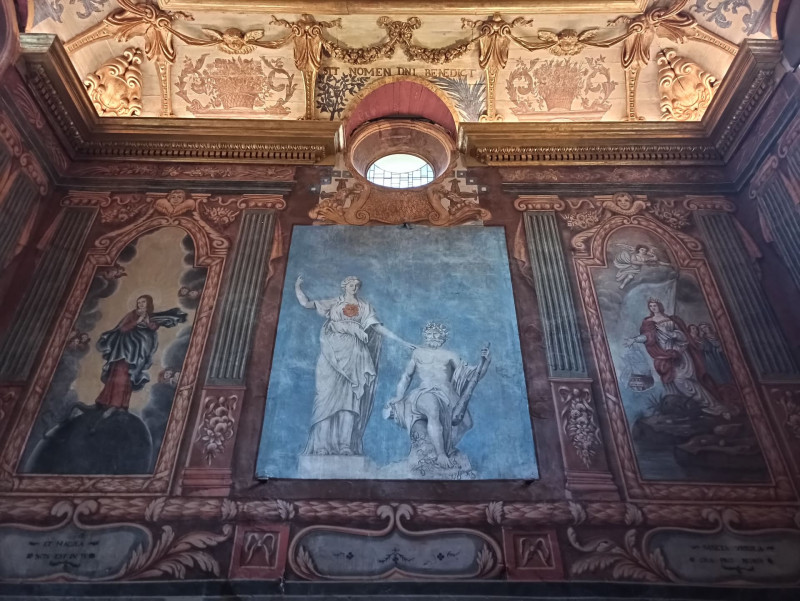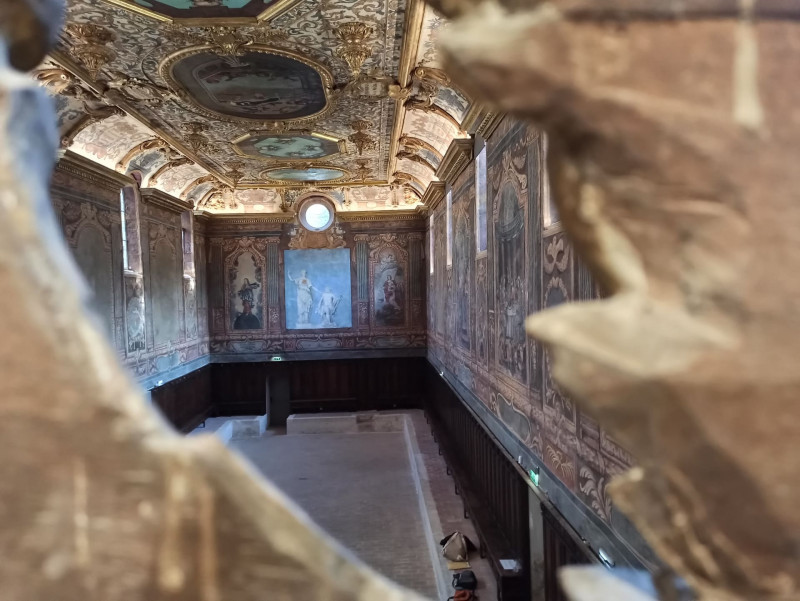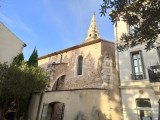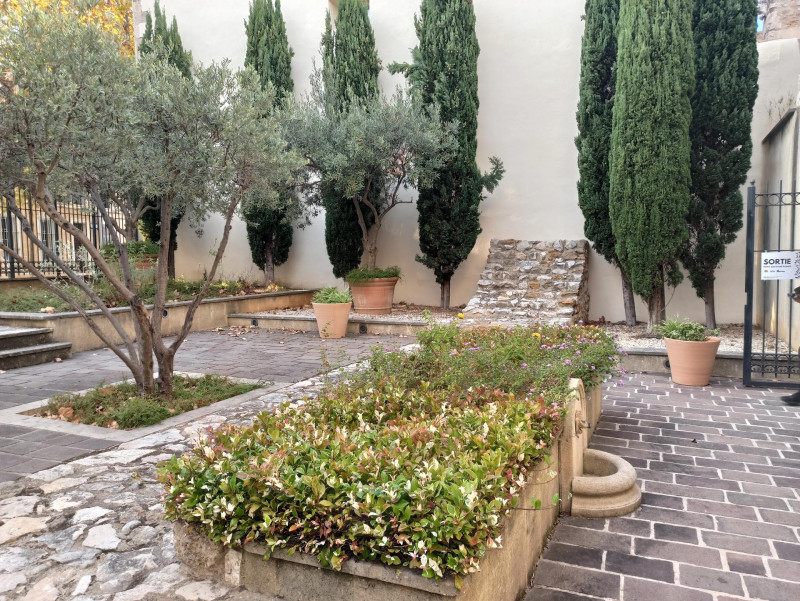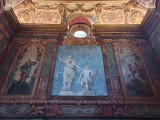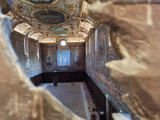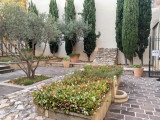Chapelle de l'Annonciade
Bad weather alternative, Recommended by high heat Historic site and monument Religious heritage ChapelPresentation
Listed as a historical monument in 1910, the chapel is located in the town centre of Martigues (Jonquières district), behind the church of St-Genest. It was built in the 17th century for the brotherhood of white penitents.
This jewel of Provençal Baroque art is a must-see! The sobriety of its exterior façade contrasts with its dazzling interior decoration: painted and ornamented ceiling, wall frescoes, painted and sculpted plant motifs, sculpted and gilded ornaments, trompe-l'oeil...
Did you know that?
- In 1619, the first mention of the chapel near the church of Saint-Genest, it was consecrated by the archbishop of Arles.
- In 1661, the chapel was demolished following the enlargement of the church of Saint-Genest. The Confraternity of the White Penitents of the Annonciade then decided to build their own chapel.
- In 1663, despite the construction of buttresses to the east (rue du Docteur Sérieux) and buttresses to the west (boulevard Richaud), the vault collapsed... the chapel no longer had a roof.
Of the old vault, a ribbed crossing is still visible from the gallery with graffiti (ships, skulls and crossbones, caricature of the revolutionary period...).
The gallery is accessible by a staircase hidden in the altarpiece, to the north of the building. Exceptionally during the European Heritage Days, you can discover the treasures hidden in this place: the walls are covered with graffiti drawn with charcoal, red chalk or a knife.
- From 1666 to 1671, the penitents opted for a flat pinewood ceiling.
- In 1677-1678, Jean-Claude Boyer, a master carpenter in Aix-en-Provence, created the sumptuous painted and ornamented ceiling. It contains five oil paintings on canvas relating to the life of the Virgin, by Barthélémy Donneau of Martigues and Anthoine Ollivier of Marseille.
The original paintings are The Assumption of the Virgin and The Coronation of the Virgin, the rest date from the 1966 restoration campaign.
- The years 1702-1703 saw the creation by Claude and Etienne Darbon of the wooden altarpiece and its majestic high altar decorated in trompe l'oeil.
- In 1734, the coloured murals illustrating the life of the Virgin and the sculpted stalls (wooden seats along the walls) were completed.
What is this brotherhood of the white penitents?
This community of lay people practised mutual aid, prayer, charity and solidarity with the poor. They were dressed in a very simple robe intended to conceal the social differences of civil clothing.
The Penitents also wore a bonnet, which showed a concern for individual modesty and anonymity so as not to take glory from their charitable actions and to erase their own person in front of the virtues of the group, so that the person assisted would only thank God for the help they received.
In order to save the chapel from the attacks of humidity, the City of Martigues decided to close it to the public in 1993 and undertook its restoration from 1995 to 2015. These 20 years of work have enabled it to be reopened to residents and tourists. The work was financed by the town, the State (historical monuments) and the Region.
Thanks to this exceptional restoration work, the city was awarded the regional Grand Prix des Rubans du Patrimoine 2016.
Its excellent acoustics make it an ideal venue for concerts. As a conservation measure, the capacity is 150 spectators.
Did you know that?
- In 1619, the first mention of the chapel near the church of Saint-Genest, it was consecrated by the archbishop of Arles.
- In 1661, the chapel was demolished following the enlargement of the church of Saint-Genest. The Confraternity of the White Penitents of the Annonciade then decided to build their own chapel.
- In 1663, despite the construction of buttresses to the east (rue du Docteur Sérieux) and buttresses to the west (boulevard Richaud), the vault collapsed... the chapel no longer had a roof.
Of the old vault, a ribbed crossing is still visible from the gallery with graffiti (ships, skulls and crossbones, caricature of the revolutionary period...).
The gallery is accessible by a staircase hidden in the altarpiece, to the north of the building. Exceptionally during the European Heritage Days, you can discover the treasures hidden in this place: the walls are covered with graffiti drawn with charcoal, red chalk or a knife.
- From 1666 to 1671, the penitents opted for a flat pinewood ceiling.
- In 1677-1678, Jean-Claude Boyer, a master carpenter in Aix-en-Provence, created the sumptuous painted and ornamented ceiling. It contains five oil paintings on canvas relating to the life of the Virgin, by Barthélémy Donneau of Martigues and Anthoine Ollivier of Marseille.
The original paintings are The Assumption of the Virgin and The Coronation of the Virgin, the rest date from the 1966 restoration campaign.
- The years 1702-1703 saw the creation by Claude and Etienne Darbon of the wooden altarpiece and its majestic high altar decorated in trompe l'oeil.
- In 1734, the coloured murals illustrating the life of the Virgin and the sculpted stalls (wooden seats along the walls) were completed.
What is this brotherhood of the white penitents?
This community of lay people practised mutual aid, prayer, charity and solidarity with the poor. They were dressed in a very simple robe intended to conceal the social differences of civil clothing.
The Penitents also wore a bonnet, which showed a concern for individual modesty and anonymity so as not to take glory from their charitable actions and to erase their own person in front of the virtues of the group, so that the person assisted would only thank God for the help they received.
In order to save the chapel from the attacks of humidity, the City of Martigues decided to close it to the public in 1993 and undertook its restoration from 1995 to 2015. These 20 years of work have enabled it to be reopened to residents and tourists. The work was financed by the town, the State (historical monuments) and the Region.
Thanks to this exceptional restoration work, the city was awarded the regional Grand Prix des Rubans du Patrimoine 2016.
Its excellent acoustics make it an ideal venue for concerts. As a conservation measure, the capacity is 150 spectators.
Individual visits during opening hours
Opening period (s)From 01/04 to 07/10 on Wednesday and Friday between 2 pm and 6 pm. On Thursday and Saturday between 10 am and 12 pm and between 2 pm and 6 pm.
Closed exceptionally on Feast of the Ascension, May 1st, May 8th, July 14th and August 15th.
Open the first Sunday of the month from 2 p.m. to 6 p.m.
From 08/10 to 31/03 on Wednesday and Friday between 1.30 pm and 5.30 pm. On Thursday and Saturday between 10 am and 12 pm and between 1.30 pm and 5.30 pm.
Closed exceptionally on January 1st, November 1st, November 11th and December 25th.
Closed exceptionally on Feast of the Ascension, May 1st, May 8th, July 14th and August 15th.
Open the first Sunday of the month from 2 p.m. to 6 p.m.
From 08/10 to 31/03 on Wednesday and Friday between 1.30 pm and 5.30 pm. On Thursday and Saturday between 10 am and 12 pm and between 1.30 pm and 5.30 pm.
Closed exceptionally on January 1st, November 1st, November 11th and December 25th.
Labels
- categories :
General information
- Parking :
- Parking nearby
- Client profile :
- Groups
- Home school groups
- Environments :
- In centre of town
- Town location
- Tour language(s) :
- Visits :
- you can visit it
- Price :
- Free
- Style :
- Baroque
- Period :
- 17th C
- Information panel language(s) :
Services, Tours, Activities and entertainment
- Group tour services :
- Guided group tours on request
- Historical patrimony :
- Historic patrimony
- Entertainment :
- Activity
- Children's entertainment
- Concert
- Handicrafts workshops
- Rooms equipped for :
- Concert/events
Accessibility
- Accessible to disabled visitors :
- Reception staff sensitized to the reception of people with disabilities
About
Health pass requested
Contact
Chapelle de l'Annonciade
Boulevard Richaud
Jonquières
13500
Martigues
Phone : +33 4 42 88 79 04
Phone : +33 4 42 49 03 30
- Spoken language(s) :
Tarifs
Free of charge.

Destination
Chapelle de l'Annonciade
Boulevard Richaud
Jonquières
13500
Martigues
GPS coordinates
Latitude : 43.403477
Longitude : 5.05448
Marseille Provence: Airport / Aerodrome at 20km
Martigues Lavéra station: Railway station at 4km
Martigues Lavéra station: Railway station at 4km

